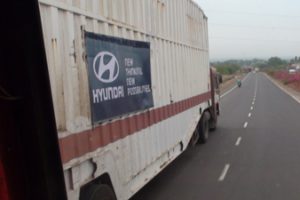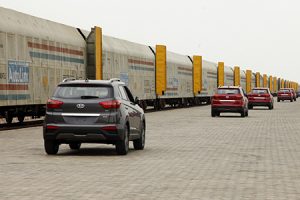New rules governing Indian car carrier sizes are set to standardise a sector that has been confusing and contradictory for over a decade
 At last, a resolution is in sight to the long-running problem over the maximum vehicle dimensions that apply to the car transporter sector in India. After years of trouble and much hand-wringing from several key stakeholders, the Ministry of Road Transport and Highways has finally settled the matter. It issued a government gazette on April 18th 2016, stating that from April 1st 2017, automotive manufacturers would not be allowed to load finished vehicles onto car transporters exceeding 18.75 metres in length.
At last, a resolution is in sight to the long-running problem over the maximum vehicle dimensions that apply to the car transporter sector in India. After years of trouble and much hand-wringing from several key stakeholders, the Ministry of Road Transport and Highways has finally settled the matter. It issued a government gazette on April 18th 2016, stating that from April 1st 2017, automotive manufacturers would not be allowed to load finished vehicles onto car transporters exceeding 18.75 metres in length.
Though the implementation date is still some months away, the new requirements were enshrined in law in May with the adoption of a fresh amendment to the Central Motor Vehicle Rules 2016, following a brief period of public consultation. Carmakers and logistics providers have even agreed a freight rate increase to help cover the costs of modifying equipment.
For many in India, it is a long-awaited clarification and move towards safer, more modern equipment. The decision comes shortly after the Chinese government made its own effort to regulate a similar issue, albeit on an even larger scale – overloaded equipment is nearly twice the technical limit – with a new standard set to come into force this summer, followed by a two-year transition period.
However India’s finished vehicle logistics sector, like that of China, will now face the major challenge of compliance. Of the 13,000 finished vehicle carriers estimated to be deployed by four-wheel carmakers in India, almost three-quarters are believed to exceed 18.75 metres in length – many of them at lengths of 22 metres or more.

Despite the safety risks associated with oversized vehicles, car-carrier dimensions and those of articulated tractor-trailers have not, up to now, been specifically included within India’s Commercial Motor Vehicle Regulations (CMVR). While the limit for other trucks has technically been 18 metres, with differences in rules and enforcement across states, this legal blind spot has kept car-carrier standards blurry. Trailer manufacturers in India have given way to the market demand for longer trucks. One European-brand trailer builder told Automotive Logistics last year that it had long struggled to fill its order books when it offered only products complying to the 18-metre rule; since it agreed to build 22-metre equipment, however, its factory has been full to capacity.
It has not been a free ride for the automotive logistics sector, however. As a result of not meeting the existing CMVR norms, truck operators delivering to dealers or to ports from car factories around the country have faced fines ranging from 2,000-3,000 rupees ($30-$45) – or bribes of at least half this level – as a matter of routine every time they cross a state border. With typical delivery routes spanning several states, relatively large sums have been changing hands for years.
The new rules, however, determine that from April next year, both articulated and drawbar combinations engaged by automobile manufacturers to carry finished vehicles from factories to sales outlets must not exceed 18.75 metres in length. From the same date, trailers and semi-trailers must be fitted with at least one sliding inspection window on one side measuring 400mm long and 300mm high and no more than 1.8 metres from the ground (all Indian car carriers are fully enclosed and so the window allows for easier verification of cargo). Tractors and prime movers involved in finished vehicle movements, meanwhile, will have to be fitted from this date with speed limiters allowing a top speed of 60kph (about 38mph), as well as rear-view cameras.
The 18.75-metre length corresponds to the standard maximum allowable length in the European Union, although some member states allow longer equipment or different lengths for vehicles to overhang in the front or rear (India’s enclosed carriers mean this is not an option here). China, by contrast, which had previously allowed only 16.5 metres (a standard almost universally ignored), will soon allow equipment that is 22 metres long.
A long time comingIndia’s story of overloaded car carriers has been quite a long, troubled saga. Abhay Damle, joint secretary of the Ministry of Road Transport and Highways, told Finished Vehicle Logistics in an interview earlier this year that automotive manufacturers had been complicit in the use of illegally oversized car transporters. During the first decade or so of this century, for example, while Indian vehicle sales and production grew substantially, manufacturers resisted an increase in freight rates from car carriers. Instead, they encouraged logistics operators to upsize and broaden their vehicles to accommodate ten small passenger cars instead of eight. With the CMVR silent on car transporters and articulated tractor-trailer dimensions, most finished vehicle carriers and trailer manufacturers switched to equipment of 22 metres or more.
Given the culture of bribes and fines this has resulted in, fleet owners have been up in arms, complaining for more than a decade both directly to manufacturers and via the carmakers’ industry association body, the Society of Indian Automotive Manufacturers. But their joint complaints have largely fallen on deaf ears, according to industry sources, who claim that OEMs have not been minded to listen for commercial reasons. The use of oversized trucks in the country has helped to keep the price of road transport artificially low, while carriers have used them as a means to meet demand and maintain higher load ratios.
 Despite greater use of rail in recent times, India remains hugely dependent on road transport for car deliveries
Despite greater use of rail in recent times, India remains hugely dependent on road transport for car deliveriesCarmakers in India also remain overwhelmingly reliant on road transport, which is responsible for some 95-97% of new vehicle movements. Although recent market reforms have paved the way for more investment in and use of rail freight for finished vehicles, and even the fledgling use of coastal ro-ro shipping, up to now OEMs have had very few options besides India’s crowded roads.
While the overloading has gone on for years, recently it started to get a somewhat higher profile in India – although not necessarily at upper government or industry levels. Following the death of four occupants of a car carrier ferrying Maruti Suzuki vehicles in April 2013, Surinder Pal Singh, senior fellow of the Indian Foundation of Transport Research and Training, wrote to all of India’s carmakers to challenge them over the fact that the car carrier involved in the accident was in contravention of rule 93 of the Central Motor Vehicle Rules 1989, with a 22.75-metre overall length and a gross vehicle weight of 28.2 tonnes – 3 tonnes over the prescribed maximum. This, suggested Singh, led to an adverse turning radius and centre of gravity, which in turn resulted in the driver losing control and crossing the carriageway. Not a single carmaker responded to his letters, however.
The results of several studies by various government bodies into the unsuitability of such carriers also seemed to make very little difference.
A number of factors eventually came together to change this scenario, however, beginning when the national government of Narendra Modi took charge in 2014. Officials at the transport ministry suggested to car transporter operators that they needed to come forward together as a single body, rather than individually, to make their case. Then came the sudden and untimely demise of a federal minister in a road accident in early 2015 which, while unconnected with car carriers, provided a fresh fillip to the whole issue of road safety on a national level, as a result of which the oversized car carrier started to be viewed as an unwieldy and serious road safety hazard.
The formation last year of the Car Carrier Association of India (CCAI) under president Vipul Nanda, founder and director of Mercurio Pallia Logistics (which is now part of the Gefco Group), was also critical, leading to a raft of meetings and discussions with the Ministry of Road Transport and Highways in an attempt to resolve the vehicle dimension issue.
“We approached the government to frame some rules for car carriers and bring them under the CMVR norms,” says Nanda. “We no longer wanted to be outlaws and punished daily across Indian states.”
What finally appears to have forced the issue was when the government of the state of Haryana (where the country’s largest carmaker Maruti Suzuki operates two plants) refused in early 2015 to issue vehicle roadworthiness certificates (known as ‘fitness certificates’ in India) to oversized car carriers when their licences came up for renewal. Officials from the state government categorically told the huge number of Haryana-registered car carriers to fall in line with the general legal provisions stipulated in CMVR or forego their fitness certificates, which would effectively prevent them from plying their trade on India’s highways.
After much discussion between carmakers, fleet owners and the Haryana government, fitness certificates were eventually issued for such vehicles, but only after owners provided a 200,000-rupee guarantee per truck that they would fall into line with the CMVR norms before the next certification date.
Meanwhile, a committee was set up under Dr Anoop Chawla at the Indian Institute of Technology in Delhi to study the issue. Its report, which ran to over 200 pages, was the final push that effectively prompted the latest legislative change.
No time to loseRealising that 22 metre-long carriers would be classified as illegal sooner rather than later, fleet operators have begun resizing their trucks. According to Vipul Nanda, more than 3,000 car carriers have already been “cut to size” at a cost of some 100,000 rupees apiece.
 "We approached the government to frame some rules for car carriers and bring them under the CMVR norms. We no longer wanted to be outlaws and punished daily across Indian states" - Vipul Nanda, Car Carrier Association of India
"We approached the government to frame some rules for car carriers and bring them under the CMVR norms. We no longer wanted to be outlaws and punished daily across Indian states" - Vipul Nanda, Car Carrier Association of India
In the meantime, the CCAI has successfully negotiated a 17% increase in freight rates for 18.75-metre long trucks to help compensate for the costs of conversion. This negotiation was not an entirely smooth one, as some manufacturers resisted paying more. Hyundai Motors India, for example, the country’s second largest passenger car manufacturer, based in Chennai in the south of the country, only agreed to the increase after a two-day strike by car carriers in March. As things now stand, all OEMs have agreed to introduce the new rate in a staggered manner as vehicles are resized, according to Nanda.
The CCAI estimates there is already an overcapacity of around 20-25% in car carriers at present across all carrier sizes and the resizing exercise will lead to an effective reduction in capacity of 20%. Though it sounds like this should leave things close to balance, Nanda says that regional disparities in demand and available capacity across India mean that that around 10% more trucks will be needed overall.
 The new rules will require enclosed car transporters like this to feature a viewing window for easier cargo verification
The new rules will require enclosed car transporters like this to feature a viewing window for easier cargo verificationTeething troublesA few problems remain though. For one, enforcement may prove to be tricky. While transport law is issued at a federal level in India, its implementation will be the responsibility of the states. Some may be better equipped than others to crack down on illegal carriers – or not to let them pass following further bribes. Even if they do, however, states stand to lose out on revenue assuming all truck operators comply with the new restriction, as they will no longer be able to fine the transporters passing through their territory.
Also, while car carriers might be relieved to have clarity, those that transport motorcycles and other two-wheelers – a huge market in India – are none too pleased. Daman Dewan, secretary of the Automobile Carriers Welfare Association (ACWA), the body that represents two-wheeler carriers, says that the ACWA was lobbying the Haryana government to delay the introduction of the new rules for a year. This was because it costs two-wheeler carriers around 300,000 rupees to convert their particular vehicles – which would need to be reduced in both length and width to meet CMVR norms – and because of the vehicle downtime and consequential revenue losses involved.
The ACWA’s demands, however, have been roundly rejected, according to Dewan, and two-wheeler carriers have until April 2017 to come into line with the new rules.
Nevertheless, the automotive logistics industry, from trucking firms to trailer manufacturers, may finally take some comfort in the fact that the long-standing uncertainty and ambiguity over carrier dimensions appears finally to be heading to a close. Though the rules have been a decade in the making, the relative expediency of the process over the past two years can be attributed to a willingness to compromise among both carmakers and truck operators.
The change in the rules may lead to more trucks on the road. However, that might not be the case, should OEMs see the multimodal transport of finished vehicles as more competitive. Furthermore, those trucks that are on the road should be safer than before and, as a result, provide a more reliable means of moving finished vehicles to customers. OEMs and their dealers will benefit from lower damage levels; car customers from more reliable delivery of their new toys; and car carriers from being on the right side of the law for the first time in many years.
“We are just happy that we will no longer be outlaws,” says Vipul Nanda.
Additional contribution by Christopher Ludwig



































